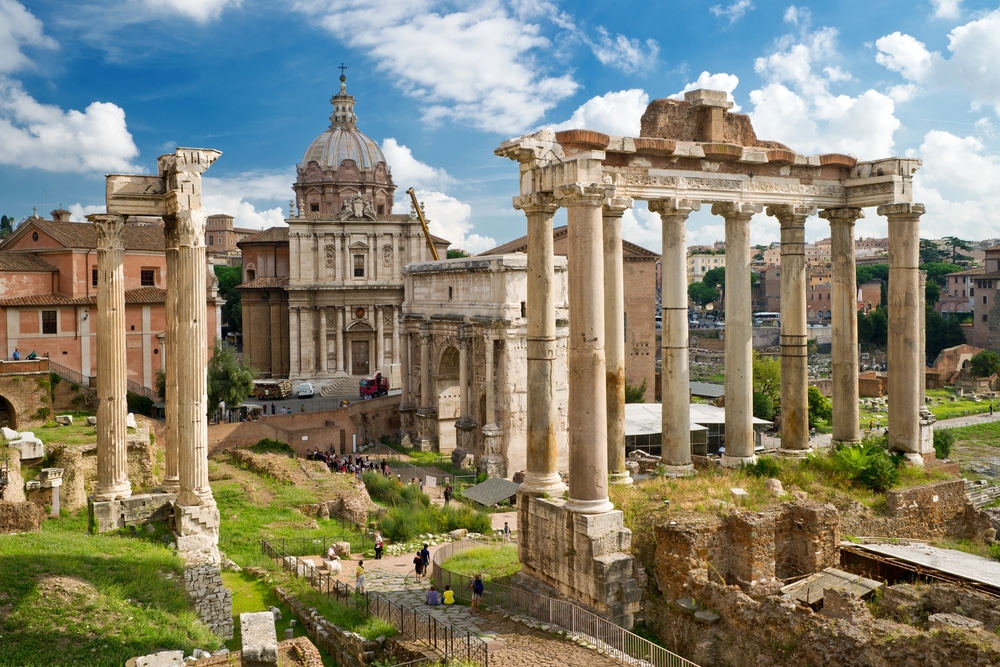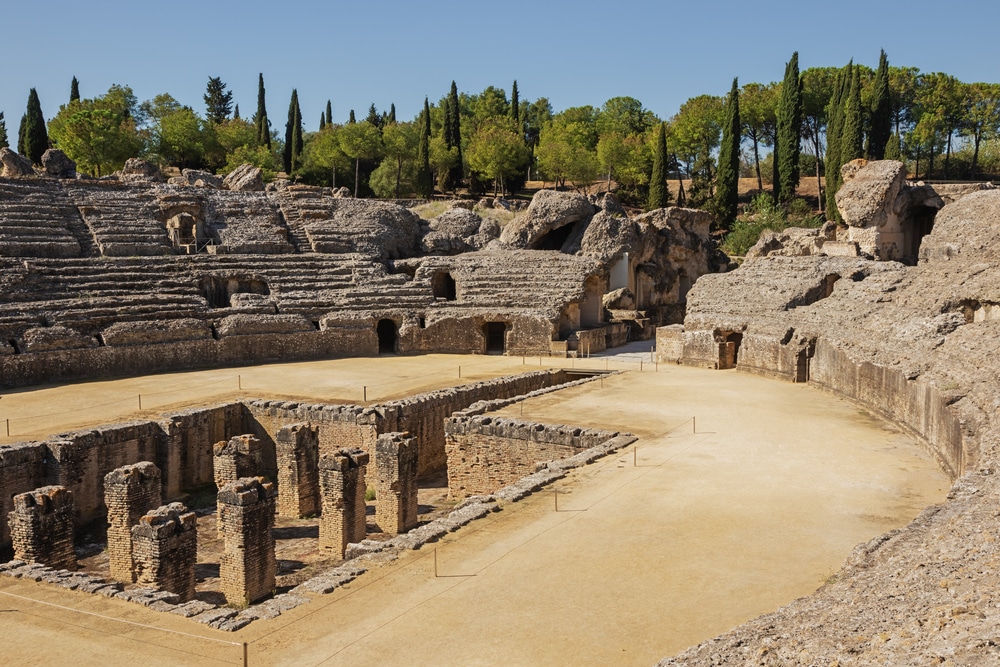Italy and Spain are absolute treasure troves of archaeological wonders. From crumbling amphitheaters to well-preserved temples, the remnants of past civilizations scattered across these lands will transport you back in time and leave you in awe of human ingenuity and artistry.
So, grab your virtual passport and let’s explore seven incredible ancient ruins that you simply must see to believe.
Trust me, these sites will make your Instagram followers green with envy and give you bragging rights for years to come!
1. The Colosseum
No list of ancient ruins would be complete without mentioning the granddaddy of them all – the Colosseum in Rome, Italy. This colossal amphitheater is probably the most recognizable ancient ruin in the world, and for good reason!
A Brief History
Built in 70-80 AD, the Colosseum was the ultimate entertainment venue of its time. Can you imagine the roar of 50,000 spectators cheering on gladiators as they battled it out in the arena? The excitement! The drama! It’s no wonder this place has captured our imaginations for centuries.
What to See
When you visit the Colosseum today, you’ll be blown away by its sheer size and intricate architecture. Don’t miss:
- The hypogeum: This underground network of tunnels and chambers is where gladiators and animals were kept before their grand entrances.
- The arena floor: Stand where countless battles took place and feel the weight of history beneath your feet.
- The upper levels: Climb to the top for breathtaking views of Rome and a bird’s-eye perspective of the arena.
Pro Tip
To avoid the crowds (and trust me, there WILL be crowds), book your tickets in advance and opt for an early morning or late afternoon visit. Oh, and don’t forget to wear comfortable shoes – you’ll be doing a lot of walking!

2. Pompeii
Pompeii is an ancient Roman city near Naples that was tragically buried under volcanic ash when Mount Vesuvius erupted in 79 AD. This disaster may have been devastating for the inhabitants, but it’s given us an unprecedented glimpse into daily life in the Roman Empire.
What Makes Pompeii Unique
Unlike many other ruins that have been exposed to the elements for centuries, Pompeii was preserved almost perfectly under layers of ash. It’s like stepping into a time capsule! You’ll see:
- Incredibly well-preserved frescoes and mosaics
- Ancient graffiti (turns out, people haven’t changed much in 2,000 years!)
- Plaster casts of victims, frozen in their final moments
Must-See Spots in Pompeii
- The Forum: The bustling heart of the ancient city
- The Villa of the Mysteries: A lavish home with stunning frescoes
- The Lupanar: An ancient… ahem… “house of ill repute” (blush)
A Word of Caution
Pompeii is huge, and it can be overwhelming. Consider hiring a guide or joining a tour to make the most of your visit. And don’t forget to bring water and sunscreen – there’s not much shade, and the Italian sun can be brutal!
Getting There
If you’re planning to visit Pompeii from Rome, consider taking the Rome to Naples train. It’s a quick and comfortable journey that’ll get you there in just over an hour. From Naples, it’s a short local train ride to the Pompeii archaeological site. This route is not only convenient but also gives you a chance to enjoy the beautiful Italian countryside along the way!
3. The Alhambra
The Alhambra is a stunning palace and fortress complex in Granada. This Moorish wonderland is a testament to the artistic and architectural brilliance of Islamic culture in medieval Spain.
A Bit of Background
Built primarily in the 13th and 14th centuries, the Alhambra was the residence of the Nasrid sultans and their court. It’s a perfect blend of natural beauty and man-made splendor, perched atop a hill overlooking Granada.
What Will Take Your Breath Away
- The intricate Islamic calligraphy and geometric patterns adorning the walls
- The serene Court of the Lions with its famous fountain
- The lush Generalife gardens, perfect for a romantic stroll
Insider Tip
Tickets to the Alhambra sell out FAST, especially during peak season. Book yours well in advance (we’re talking months here, folks) to avoid disappointment. And if you can, try to visit during the magical evening hours when the palace is illuminated – it’s absolutely enchanting!
Exploring More of Spain
After marveling at the Alhambra, why not continue your Spanish adventure? Many travelers opt to take the train from Barcelona to Madrid, which is a great way to see more of the country. While Granada isn’t on this direct route, you could easily incorporate it into a larger Spanish itinerary. The high-speed train between Barcelona and Madrid is a comfortable and efficient way to travel, allowing you to experience the diverse landscapes and cultures of Spain.

4. The Roman Forum
This sprawling complex of ruined temples, government buildings, and public spaces was once the center of Roman life. It’s where history was made, folks!
Why It’s a Must-Visit
The Roman Forum gives you a real sense of what daily life was like in ancient Rome. As you wander through the ruins, you can almost hear the echoes of impassioned speeches, bustling markets, and religious ceremonies.
Highlights of the Roman Forum
- The Temple of Saturn: One of the oldest structures in the Forum
- The Arch of Titus: A triumphal arch commemorating Roman victories
- The House of the Vestal Virgins: Home to the priestesses who tended the sacred flame
Make the Most of Your Visit
The Forum can be confusing to navigate, so consider getting an audio guide or joining a tour. And here’s a pro tip: climb up to the Palatine Hill for an amazing bird’s-eye view of the entire complex. It’ll help you make sense of the layout and appreciate the scale of this ancient city center.
5. The Aqueduct of Segovia
This massive structure has been bringing water to the city for nearly 2,000 years. Talk about built to last! The aqueduct is an absolute behemoth, stretching over 17 kilometers (10 miles) from the Frío River to Segovia.
But the most impressive part is the section that runs through the city center. Picture this: 167 arches made of massive granite blocks, stacked without any mortar, reaching heights of up to 28.5 meters (93.5 feet). It’s mind-boggling!
What to Look For
- The two-tiered arches in the city center
- The slight gradient that allows water to flow naturally
- The marks left by the original Roman tools used to cut the stones
Fun Fact
Legend has it that the aqueduct was built by the devil in a single night. But between you and me, I think the Romans deserve the credit for this one!
6. The Valley of the Temples
Let’s hop over to Sicily, Italy’s largest island, and explore the Valley of the Temples in Agrigento. Despite its name, this archaeological site isn’t in a valley at all – it’s actually on a ridge! But don’t let that fool you; it’s home to some of the best-preserved ancient Greek temples outside of Greece itself.
A Bit of History
Founded in the 6th century BC, Agrigento (then called Akragas) was one of the richest and most important Greek colonies in the Mediterranean. The temples were built to show off the city’s wealth and power – and boy, did they succeed!
Must-See Temples
- Temple of Concordia: One of the best-preserved ancient Greek temples in the world
- Temple of Juno: Perched on the edge of a ridge with stunning views
- Temple of Heracles: The oldest temple in the valley
Time Your Visit Right
The Valley of the Temples is beautiful at any time of day, but if you can, try to visit at sunset. The golden light illuminating the ancient stones is simply magical. And if you’re lucky enough to be there in February or March, you’ll see the almond trees in full bloom – it’s like something out of a fairy tale!

7. The Ruins of Italica
For our final stop, let’s venture off the beaten path to Italica, just outside Seville in southern Spain. This ancient Roman city might not be as famous as some of our other stops, but it’s a hidden gem that’s well worth a visit.
Why Italica is Special
Italica was the birthplace of Roman emperors Trajan and Hadrian, and it shows in the city’s grandeur. It’s also much less crowded than many other Roman ruins, so you can really take your time and soak in the atmosphere.
What to See in Italica
- The amphitheater: One of the largest in the Roman Empire
- The House of the Planetarium: Features a beautiful mosaic of the gods of the seven days of the week
- The baths: Well-preserved Roman public baths with intricate mosaics
Game of Thrones Fan?
If you’re a fan of the show, you might recognize Italica’s amphitheater as the Dragonpit in King’s Landing. How cool is that?
A Journey Through Time
From the mighty Colosseum to the hidden treasures of Italica, we’ve explored some of the most incredible ancient ruins that Italy and Spain have to offer. These awe-inspiring sites are more than just crumbling stones – they’re windows into the past, offering us glimpses of the lives, beliefs, and achievements of those who came before us!



